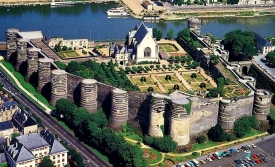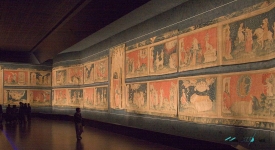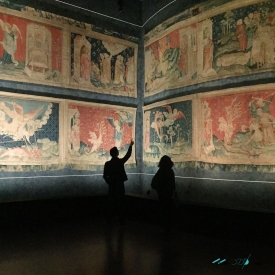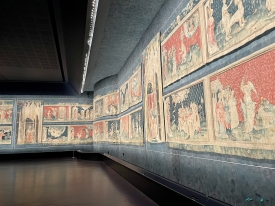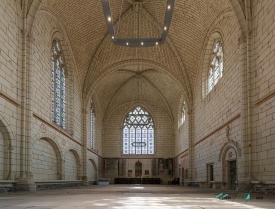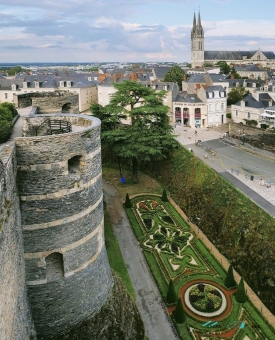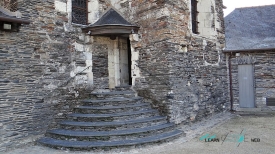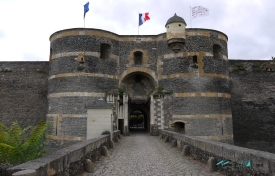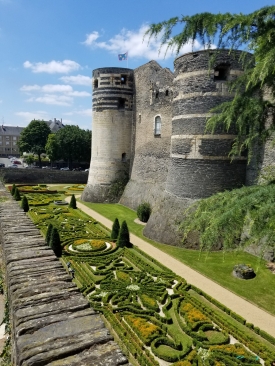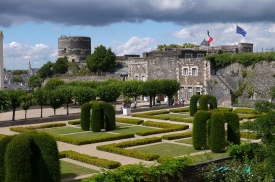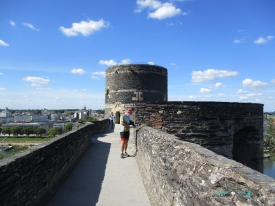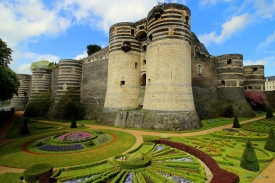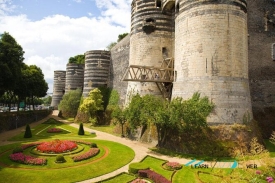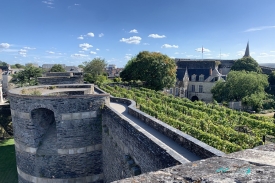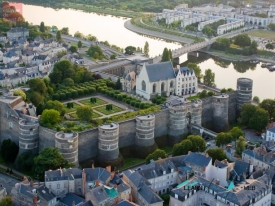The Château d'Angers is located near the confluence of the Maine and Loire rivers. Angers is today the capital of the Maine-et-Loire department in the Pays de la Loire region; It was the ancient capital of Anjou.
A Neolithic burial reveals that the first signs of human habitation on the rocky promontory overlooking the Maine River date back to 4,000 years before our era. The territory was later occupied by the Gauls and later by the Romans.
The fortress was built from 1230 under the regency of Blanca de Castilla and her young son San Luis. To carry it out, the canons of Saint-Laud are expelled, as well as part of the inhabitants of the city to be able to build a 2.5-hectare fortress. Nearly a quarter of the former canonical district of Saint-Maurice d'Angers was also destroyed to allow for expansion of the fortress. For the construction of the castle, the royal treasury pays more than 5,000 pounds, and a tax is levied on the bourgeois of Angers. The construction took a dozen years (1230-1242) of what is the birth certificate of the fortress, one of the most beautiful fortifications of the 13th century, as it is perceived today: an enclosure of more than 800 meters long dotted with seventeen round towers over forty meters high. Only the steep northern flank, facing the Maine, was never fortified.
At the end of the 16th century, in order to adapt the fortress to the progress of the artillery, in particular the appearance of the cannon, the towers lost about twenty meters and their conical roofs, giving the castle its current silhouette.
The Dukes of Anjou, related to the King of France, spent time in the fortress during the 14th and 15th centuries. Louis I of Anjou modernizes the count's palace, Louis II builds the chapel and King René builds the royal residence (1435-1440) and the castle (1450) that ostentatiously encloses the ensemble of the stately courtyard. At this time, light architecture and an extraordinary zoo with domestic and exotic animals are scattered throughout the gardens.
Likewise, Louis I of Anjou had the tapestry of the Apocalypse woven in 1375. Of its original 140 meters, only a hundred have been preserved and exposed to the public. The tapestry illustrates the text of Saint John, the last book of the Bible. It also reflects the unrest at the end of the 14th century, the climax of the Hundred Years' War. Made in a period of great cultural effervescence, with exceptional financial and technical means, it reveals the talent of the master cartoner Jean de Bruges, painter to the king. The Apocalypse tapestry is exhibited in a gallery specially designed and fully equipped to guarantee the best conservation conditions for the work.
During the Revolution, the castle became the headquarters of the Revolutionary Committee of Angers. At the beginning of the year Messidor I (end of June 1793), the Vendeans, returning from Virée de Galerne, unsuccessfully besieged the city and its castle. The fortress was used as a prison during the revolutionary time of terror.
The castle-fortress was a burial place for seven centuries. In the first half of the 19th century, the castle functions as a departmental prison for common prisoners and the mentally ill. The fortress worked as a military barracks until the first half of the 20th century. The march of the army in 1947 allowed its opening to the public and the return to its walls of the Apocalypse tapestry that King René had bequeathed to the Angers cathedral.
The enclosure houses some exceptional gardens of great diversity: the regular garden planted with boxwoods and yews, the vineyard, the orchard, the rose garden, the hydrangea garden of the royal residence, the suspended garden and its medicinal and dye plants... The castle of Angers is therefore a very rich place, full of archaeological remains, a royal fortress, ducal buildings from the late Middle Ages and the Apocalypse tapestry, the greatest work of medieval tapestry due to its size, age and technique.
Between 1992 and 2003, AFAN and then INRAP carried out a series of preventive archaeological excavations as part of the renovation of the Apocalypse gallery. These excavations allow, in particular, the updating of the remains of the Count's palace, as well as the remains of the Neolithic, Gallic and Roman occupations. In 2007 the reception and ticket sales area was renovated. In February 2009, a new reception area was opened for the Galerie de l'Apocalypse. This includes a shop and a glassed-in space that allows for the presentation of the Neolithic cairn and the remains of the count's palace chambers.
A Neolithic burial reveals that the first signs of human habitation on the rocky promontory overlooking the Maine River date back to 4,000 years before our era. The territory was later occupied by the Gauls and later by the Romans.
The fortress was built from 1230 under the regency of Blanca de Castilla and her young son San Luis. To carry it out, the canons of Saint-Laud are expelled, as well as part of the inhabitants of the city to be able to build a 2.5-hectare fortress. Nearly a quarter of the former canonical district of Saint-Maurice d'Angers was also destroyed to allow for expansion of the fortress. For the construction of the castle, the royal treasury pays more than 5,000 pounds, and a tax is levied on the bourgeois of Angers. The construction took a dozen years (1230-1242) of what is the birth certificate of the fortress, one of the most beautiful fortifications of the 13th century, as it is perceived today: an enclosure of more than 800 meters long dotted with seventeen round towers over forty meters high. Only the steep northern flank, facing the Maine, was never fortified.
At the end of the 16th century, in order to adapt the fortress to the progress of the artillery, in particular the appearance of the cannon, the towers lost about twenty meters and their conical roofs, giving the castle its current silhouette.
The Dukes of Anjou, related to the King of France, spent time in the fortress during the 14th and 15th centuries. Louis I of Anjou modernizes the count's palace, Louis II builds the chapel and King René builds the royal residence (1435-1440) and the castle (1450) that ostentatiously encloses the ensemble of the stately courtyard. At this time, light architecture and an extraordinary zoo with domestic and exotic animals are scattered throughout the gardens.
Likewise, Louis I of Anjou had the tapestry of the Apocalypse woven in 1375. Of its original 140 meters, only a hundred have been preserved and exposed to the public. The tapestry illustrates the text of Saint John, the last book of the Bible. It also reflects the unrest at the end of the 14th century, the climax of the Hundred Years' War. Made in a period of great cultural effervescence, with exceptional financial and technical means, it reveals the talent of the master cartoner Jean de Bruges, painter to the king. The Apocalypse tapestry is exhibited in a gallery specially designed and fully equipped to guarantee the best conservation conditions for the work.
During the Revolution, the castle became the headquarters of the Revolutionary Committee of Angers. At the beginning of the year Messidor I (end of June 1793), the Vendeans, returning from Virée de Galerne, unsuccessfully besieged the city and its castle. The fortress was used as a prison during the revolutionary time of terror.
The castle-fortress was a burial place for seven centuries. In the first half of the 19th century, the castle functions as a departmental prison for common prisoners and the mentally ill. The fortress worked as a military barracks until the first half of the 20th century. The march of the army in 1947 allowed its opening to the public and the return to its walls of the Apocalypse tapestry that King René had bequeathed to the Angers cathedral.
The enclosure houses some exceptional gardens of great diversity: the regular garden planted with boxwoods and yews, the vineyard, the orchard, the rose garden, the hydrangea garden of the royal residence, the suspended garden and its medicinal and dye plants... The castle of Angers is therefore a very rich place, full of archaeological remains, a royal fortress, ducal buildings from the late Middle Ages and the Apocalypse tapestry, the greatest work of medieval tapestry due to its size, age and technique.
Between 1992 and 2003, AFAN and then INRAP carried out a series of preventive archaeological excavations as part of the renovation of the Apocalypse gallery. These excavations allow, in particular, the updating of the remains of the Count's palace, as well as the remains of the Neolithic, Gallic and Roman occupations. In 2007 the reception and ticket sales area was renovated. In February 2009, a new reception area was opened for the Galerie de l'Apocalypse. This includes a shop and a glassed-in space that allows for the presentation of the Neolithic cairn and the remains of the count's palace chambers.



